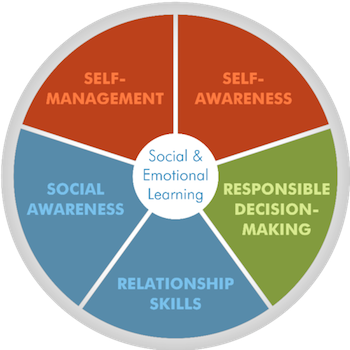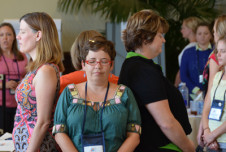According to a recent Collaborative for Academic, Social, and Emotional Learning (CASEL) report, a whopping 83 percent of teachers stated that they want training in social-emotional learning (SEL) skills. Yet a recent scan of Canadian and U.S. teacher education programs conducted by one of us (Kim) and Dr. Shelley Hymel—both from the University of British Columbia—showed that very few pre-service teachers are actually receiving training in SEL.
The lack of SEL training for teachers has consequences for students. Consider this: Another revealing study showed that teachers who didn’t buy into the SEL curriculum that they were using in their classroom actually worsened their students’ SEL skills.
 Collaborative for Academic, Social, and Emotional Learning's five dimensions of SEL
Collaborative for Academic, Social, and Emotional Learning's five dimensions of SEL
Most likely, these teachers had never been exposed to the large body of research that shows a positive connection between SEL skills and students’ academic and life success. And they were probably even less aware of the impact of their own social-emotional competencies on their ability to be effective teachers.
The need and demand for SEL in the classroom is growing—and so is the science behind it. But mainstream education has yet to make it foundational to the learning and teaching process. For SEL to be integrated fully into teacher training, a three-pronged approach is required, starting with training for aspiring teachers before they enter the classroom.
SEL growing in North America
Using CASEL’s five dimensions of SEL as a guiding framework, the scan examined the degree to which SEL is incorporated into the following three categories in teacher prep programs:
- Social-emotional learning of students;
- Social-emotional competencies of teachers; and
- The learning context, including classroom management, school-wide coordination, and supporting school-family-community partnerships.
The scan revealed that 31 percent of states and territories required teachers to have knowledge and/or skills to promote all five dimensions of SEL of their students. This promising finding shows that the field of education is steadily beginning to embrace the importance of SEL for student success.
However, only nine states or territories required the development of some of the SEL dimensions in the pre-service teachers themselves, and not a single one required all five. While many in the education profession implicitly recognize the relationship between a teacher’s social-emotional skills and the creation of a safe and caring classroom environment, this finding reveals that teacher prep programs lag in their understanding that these skills can and should be taught.
Finally, almost every state and territory required some knowledge of the learning context, yet a negative rather than a positive approach was often emphasized. For example, instead of teaching pre-service educators how to create caring, supportive teacher-student relationships, many courses on classroom management focus on disciplining student misbehavior.
A three-pronged approach to integrating SEL
For SEL to be integrated fully into teacher training, we believe a three-pronged approach is required.
First, pre-service teachers need SEL content: what it is, the science behind it, and how to use it to structure lessons, effectively implement SEL programs, and create positive learning environments.
The next two prongs concentrate on the actual application of SEL in the classroom, starting with the mentoring of pre-service teachers during their student teaching and then continuing for at least the first two years of in-service teaching.
 © iofoto
© iofoto
For example, mentors can help teachers—both new and experienced—learn to reflect and develop their self-awareness so that they can understand how their own past experiences might be influencing their responses to students.
Kim learned about the importance of reflection early in her teaching career when she taught at a Chicago-based residential treatment institution for students with severe emotional and behavioral disorders.
In order to be effective with students, she was mentored to constantly reflect on her response to them. Instead of reacting to a student who was pushing her buttons with, “Oh, that kid’s just a jerk,” Kim was taught to ask, “Why am I having this response? Why is the way this kid is behaving bringing up this emotion in me?” Through this training, she learned to become aware of how her emotions could influence a student’s behavior.
One memorable incident with a student named Jess really drove this need for reflection home to her. When Kim forgot to bring Jess money so that he could go out and meet friends—a coveted privilege—he lashed out at her. They quickly became engaged in a shouting match until the director of the school came into the room and asked what was going on.
In her very calm manner, the director said, “Let’s figure out what the problem is. Jess, you know Kim was very busy getting all her materials together. But Kim, can you see why Jess is upset? Jess, tell Kim how much seeing your friends meant to you.”
Jess responded, “You know how important being allowed to meet my friends is to me. So now I feel like you really don’t care about me because you forgot the money.” Kim immediately understood how her reaction to Jess had caused him to explode.
Rather than responding to students with harshness and judgment, Kim was coached to have empathy for the students. She learned to lead with compassion and care so that the students would learn to trust her and be able to say when faced with a difficult situation, “When you act like that, it makes me feel unloved.”
SEL Training for In-Service Teachers
Until learning and practicing SEL skills is mandated in teacher education programs, many teachers are on their own to seek out this information. Several programs exist for educators who would like to receive training in SEL:
- Greater Good Science Center’s Summer Institute for Educators
- Garrison Institute’s CARE for Teachers program
- Passageworks’ SMART-in-Education program
- SEL Masters Program at the University of British Columbia
- Margaret Cullen’s Mindfulness-Based Emotional Balance
- FuelEd teacher training program
What would the world look like today if the teachers of yesterday had been schooled in the latest SEL techniques? Imagine that you could say that each of your teachers had made an effort to get to know you as an individual. That each one made the classroom a safe place to take risks and make mistakes. And that when you got a little out of control, each teacher dealt with you in a way that helped you maintain your dignity and encouraged you to have a little more self-control?
Now imagine that as a teacher, you could do this for all your students.
How different would all our lives be?







Comments